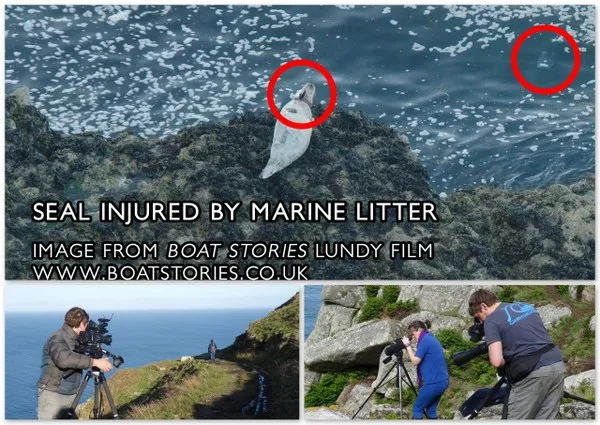Following several sneaky cameo appearances, North Devon's
iconic Lundy passenger and supply boat the MS Oldenburg has her own starring
role in Living and Working on Lundy Island, the latest short film in the Boat
Stories series.
In the Boat Stories series so far we have been up the rivers
and out to sea, often catching a glimpse of the Oldenburg as she sails out of
Bideford or Ilfracombe. We now travel with
her out to Lundy to meet the Island's warden Beccy MacDonald.
On an island with a tiny working population, Lundy workers
learn to multi task. Beccy overseas research
projects and, working in the field herself, monitors puffins and surveys seals. She meets the Oldenburg as it delivers day
trippers, wildlife enthusiasts and researchers and offloads essential supplies
- like clotted cream - she keeps visitors informed - running guided walks and
snorkel safaris. As a member of the
island coastguard team Beccy's radio crackles constantly as she is the contact
for all visiting charter boats and fishermen. Along with Jonny, her partner, Beccy fills divers’ air bottles and when
housekeeping is stretched in the busy season, like the rest of the team and
volunteers, she mucks in to help with bed making!
This short film captures the beauty of the island and its
wildlife but also highlights an issue which is having an impact on marine life
in North Devon and around the world.
Boat Stories Producer, Jo Stewart-Smith says "We were
walking along the coast path filming Beccy doing her seal survey when she
turned and said ‘there’s something here I really want you to film.’ She’d
spotted the pale seal with some plastic caught around its neck, which a diver
had reported to her. While the other seals, hauled out next to it relaxed,
totally chilled, the pale seal was rubbing her neck and scratching at it with
her flipper. Beccy explained that unfortunately because Lundy is a rocky island
it would be impossible to dart the seal to try and remove the entanglement
because she’d jump straight into the sea and drown. 'It may upset people' she
said, 'but it is something they should be aware of – the marine litter has
quite a negative impact on all our wildlife, even on something as large as a
seal.'"
Natalie Gibb from North Devon Coast AONB led Clean Marine
project adds “It’s a fabulous film. Although incredibly sad, the example
of the entangled seal on Lundy is a great way to put the issue of marine litter
into perspective. I’ve seen many distressing images of injured wildlife, but I
have never witnessed it directly, especially so close to home. It’s something
that I hope many people can all relate to, with it happening right on our
doorstep. It also reminds us that every piece of rubbish the Clean Marine and
other volunteers pick up is worth removing. It’s that little bit of incentive
we all need to keep us going when we head out on our next beach clean.”
Along with the other Boat Stories short films, Living and
Working on Lundy can be viewed on the Boat Stories website
www.boatstories.co.uk where you can read more about the making of the film. Additionally, this coming September and
October there will be two free Boat Stories celebration events, in Bideford and
Ilfracombe, where members of the public will be able to view the complete
series of films and meet the contributors and crew.
Simon Vacher filming Lundy warden, Beccy MacDonald
MS Oldenburg ferry sailing to Lundy
Photos copyright Boat Stories Jo Stewart-Smith (All rights reserved)
-----------------------
The Boat Stories
series of short films is available to view free online at
www.boatstories.co.uk.
Filmed and edited by Simon Vacher
Music by Rosamund Harper
Directed & produced by Jo Stewart-Smith

